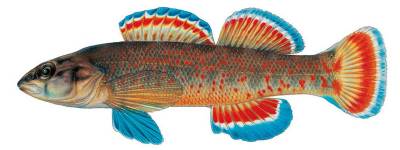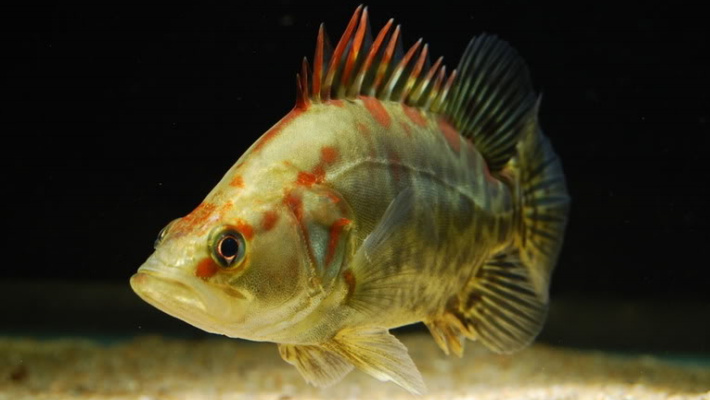|
Dorsal fins
in freshwater fish are located on the upper most illuminated part of the fish’s
body. Therefore, clearly visible colored patterns of dorsal fins can play an
important role in fish behaviour.
Color
patterns of dorsal fins can be divided into several groups.
Uniform Color Patterns
More
or less uniformly colored yellow, orange and red dorsal fins without additional
marks occur in many freshwater fish, first of all in cyprinid fish such as roach,
Rutilus rutilus, rudd, Scardinius erythrophthalmus, and more. In roach, for example,
the rear part of dorsal fin is constantly red, this fin can be folded and rise. Theoretically, roach can
fold its red dorsal fin with the approaching of natural predators (like perch, Perca fluviatilis, or pike, Esox lucius), becoming cryptic, and rise
it using as red signals to contact with schooling and sexual mates.
Sail Fins
Studies of variable platyfish, Xiphophrus
variatus, and other poeciliids point out to female biases for males with
larger dorsal fin size and lateral projection area (LPA). Using dummy females
varying in dorsal fin size, body size, and dorsal fin to body size ratio, MacLaren
& Fontaine (2013) have found that males
prefer larger bodied females when fin size and total LPA are constant, but not
for larger fins when body size are constant (see data by MacLaren et al., 2004, for sailfin
molly, Poecilia latipinna) . Unlike
the permissive preferences of females, males are able to discriminate between
female body size (as an visual indicator of fecundity) and fin size.
Dorsal Fins with Small Spots
This
group of colored patterns includes relatively small spots located on the
inter-ray tissue of dorsal fins.
Color
patterns of this type occur, for example, in graylings such as the European
grayling, Thymallus thymallus, and
other species with their huge dorsal fins. Dorsal fins of these fish are
covered with the chromatic inter-ray spots that form irregular or regular (row)
patterns (e.g., Knizhin et al., 2006). In general, rainbow colored dorsal fins
of graylings are an element of cryptic rheophilous, or stream coloration. At
the same time dorsal fins are used both in agonistic (fin lateral displaying) and
spawning (fin
clasping) behaviour
(e.g., Kratt
& Smith, 1980; Darchambeau
& Ponchin, 1997). Dorsal fins in graylings have commonly colored edge rims, adipose fins
may be red similar to other salmonids like brown trout, Salmo trutta, both in parr and adults.
In males of
cichlid fish, Astatotilapia burtoni,
dorsal fins are covered with numerous spots (yellow, orange or reddish) located
on each inter-ray space and formed some longitudinal regular rows, togerther
with the edge row-like rims (Henning & Meyer, 2012).
Dorsal Fins with Large Spots
In addition
to spotted dorsal fins, anal fins in males of A. burtoni are covered with 4-8 large spots that occupy several
inter-ray spaces and mimic eggs ((e.g., Henning & Meyer, 2012; Theis et
al., 2012). As shown in aggression trials (Theis et al., 2012), males of A. burtoni with fewer egg-spots receive more
attacks of rivals, suggesting that egg-spots are an important signal (that
refers to 1500 species of cichlids with egg-spots in males).
Cichlid
fish called kribensis, Pelvicachromis
pulcher, have some large egg-sports in the rear part of the dorsal fin and
the upper part of the caudal fin.
Single Patch
In
freshwater fish, large spots or patches that occupy all or an appreciable part
of dorsal fins are very visible and play an important role mainly in schooling,
alarm and aggressive behaviour (Guthrie, 1986). For example, dorsal fin yellow in the
base, black and white on the tip is actively used in characin fish, Pristella riddlei (Keenleyside, 1955),
in schooling and alam behaviour. According to manipulative experiments
conducted by Petfield (1983), large black and white dorsal fin spot in perch, P. fluviatils, is an important stimulus
for conspecific aggregation. Many of single patch patterns of dorsal fins in
freshwater fish are reviewed by Guthrie (1986), but most of them are waiting for detailed description,
systematization and validation of the
signaling role. Edge Rims
Colored
rims are developed in many freshwater fish commonly on the dorsal, caudal and
anal fins. For example, white, yellow and blue rims occur in breeding black
males of gobiid fish. Brightly colored blue and red fin rims are developed in
breeding males in many species of darters.
In
gobies, colored rims display the readiness of males for spawning and called
gamosematic signals. These temporary edge rims disappear when males begin to
care for the nests with laying eggs. 
Figure 1. Colored rims in redspot darter, Etheostoma artesiae (powered by Joseph Tomelleri)
Club Like Fins
Fleshy
proliferations are well developed on the fins of breeding males in
egg-clustering darters of the subgenera Boleosoma
and Catonotus of the genus Etheostoma. Shape and pigmentation,
commonly white and yellow, of these knobs suggest that they function as
egg-mimics (e.g., Bart & Page, 1991; Page et al., 2000). Size of egg-mimics
can achieve 1,8 – 2.2 mm (Page et al., 2000). Breeding males of darters
typically develop fleshy proliferations on spines, rays of anal, pelvic and pectoral
fins. Only in Boleosoma and Catonotus, which uniquely share the egg-clustering
behavior, breeding males have fleshy masses on the tips of the dorsal fin
elements.
Basic References
Bart H.L.Jr., Page L.M. 1991. Morphology and adaptive significance of fin
knobs in egg-clustering darters. Copeia 1991, 80-86
Darchambeau
F., Ponchin P. 1997. Field observations of the spawning behaviour of
European grayling. Journal of Fish
Biology 51, 1066-1068
Guthrie
D.M. 1986. Role of vision in fish behaviour. In: The behavior of teleost fish
(Pitcher T.J. Editor). Johns
Hopkins University
Press, Baltimore, Maryland, 75-113
Henning F., Meyer A. 2012. Eggspot number and sexual
selection in the cichlid fish Astatotilapia
burtoni. PLoS ONE 7(8): e43695
Keenleyside
M.H.A. 1955. Some aspects of the schooling
behaviour of fish. Behaviour 8, 183-249
Knizhin I.B., Bogdanov
B.E., Vasil’eva E.A. 2006. Biological and morphological characteristic of the Arctic grayling Thymallus
arcticus (Thymallidae) from alpine lakes of the basin of the upper reaches of the Angara
river. Journal of Ichthyology 46, 709-721
Kratt L.F., Smith
R.J.F. 1980. An analysis of the spawning behaviour of the Arctic
grayling Thymallus arcticus
(Pallas) with observations on mating success. Journal of Fish Biology 17, 661-666
MacLaren
R.D., Rowland J.W., Morgan N. 2004. Female preferences for sailfin and body
size in the sailfin molly, Poecilia
latipinna. Ethology 110, 363-379
MacLaren
R.D., Fontaine A. 2013. Incongruence between the sexes in preferences for body and dorsal fin
size in Xiphophorus variatus. Behavioural
Processes
92, 99-106
Page L.M., Knouft
J.H., Schaefer S.A. 2000.
Variation in egg-mimic size in the guardian darter, Etheostoma oophylax
(Percidae). Copeia 2000, 782-785
Patfield
I.M. 1983. Visual aspects of intraspecific recognition in the perch (Perca fluviatilis L.). University of Manchester
Theis A., Salzburger W., Egger B. 2012. The function of
anal fin egg-spots in the cichlid fish Astatotilapia
burtoni. PLoS ONE 7(1): e29878
|








 SUBSCRIBE
SUBSCRIBE



